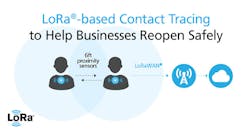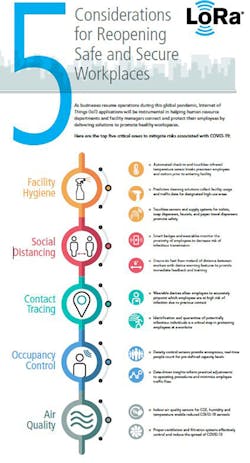Return to the Office Safely with IoT Tech
This article appeared in Evaluation Engineering and has been published here with permission.
What you’ll learn:
- How IoT-based solutions can enable a safe return to the office.
- The benefit of long-range, low-power technology to support the IoT.
The COVID-19 pandemic presented the world with striking challenges. As restrictions continue to lift, businesses are responding by leveraging Internet of Things (IoT) technologies to balance health and safety concerns while employees return to office work settings. This is critical since many employees are hesitant about the “return to normal.”
Early on in the pandemic, a study from Just Capital found that 90% of Americans wanted companies to prioritize health and safety in the wake of the COVID-19. More recent research suggests there’s still a lot of fear from employees when it comes to returning to the office. Despite being vaccinated themselves, many employees still seek additional measures taken by their employers when it comes to comfort level and assurance of health and safety.
As more companies welcome employees back to in person settings, the pressure on these businesses is mounting to provide a safe work environment. Luckily, there are four key ways that connected technology can be used to ensure safety in office work settings:
Proximity Sensing & Contact Tracing
Whether restrictions are fully lifted or just relaxed, many businesses can continue enforcing safe social-distancing practices and contact tracing in the office so their employees feel more confident about working in a co-located physical workplace. The ability to automate monitoring of new safety policies, while empowering employees as part of the new normal in business operations, is critical for any organization.
Over the past year, there have been significant developments around contact tracing. This technology went from a slightly unknown commodity to an imperative necessity, but issues remain. In several countries, manufacturers are developing and testing contact-tracing apps for smartphones, but these apps are collecting and storing data about an individual’s whereabouts 24 hours a day. While contact tracing is important, it should not compromise the privacy of individuals when they are outside the office. Companies can choose a less intrusive method, and are able to do so with IoT technology.
The ideal solution would leverage wearables over a smartphone with support for robust long-range wireless communications to alert when employees may have been exposed to a co-worker or visitor who tests positive. At the same time, these wearables also can be used for proximity sensing, alerting employees when they are closer than the allotted distance. Employees can confidently bring their wearable device to work knowing that their privacy is protected because the only environment in which they are traceable is within company premises.
People Counting Solutions
As capacity limits increase across the board, it is critical for employers to monitor their office spaces to ensure appropriate public health guidelines are being followed. However, office monitoring is an incredibly difficult task.
With common spaces, conference rooms, desk areas, and other spaces, there are a lot of different elements to look after. All must be accounted for, requiring attention-to-detail and efficiency from employers throughout this process. Occupancy monitoring technology provides real-time insights on population activity, measuring the effectiveness of social distancing and other public health guidelines based on local compliance with these regulations.
Employers can use a number of different IoT-based solutions, including density control sensors to provide anonymous, real-time people counting in different spaces set for pre-defined capacity levels. Employers also may enable solutions that involve green-red “traffic light” alerts to regulate access to buildings. The key is that all of these solutions can be used to inform practical adjustments to operating procedures and flow throughout an office space.
Air-Quality Monitoring
Scientific research has indicated that quality airflow is a key to increasing protection and slowing the spread of COVID-19. The Centers for Disease Control and Prevention (CDC) recommends multiple mitigation strategies to combating COVID-19, including significant improvements to building ventilation to reduce the spread of disease and lower the risk of exposure. In doing so, looking to carbon dioxide (CO2) in combination with humidity and temperature will be a reliable indicator for indoor air quality, which can now be measured in real time thanks to IoT-based solutions.
IoT-based building and indoor environment monitoring solutions are extremely innovative and comprehensive tools in minimizing the spread of COVID-19 in support of safe building and workspace re-occupancy. Indoor air-quality sensors for CO2, humidity, and temperature can enable reduced COVID-19 aerosols. Long-range and low-power technology is particularly critical here as building layouts can be diverse and sensors can be hidden in or around walls and the ceiling.
Maintaining humidity levels between 40% and 60% is proven to reduce the transmission of viruses. The utilization of these continuous environmental monitoring solutions, including the measurement of humidity and CO2 levels and optimizing ventilation, is crucial in helping businesses reoccupy in a post-COVID world.
Hygiene-Monitoring Solutions
The COVID-19 pandemic had a major impact on all of us, especially our behavior and mindset when it comes to hygiene. Businesses should focus on enhanced cleaning and disinfecting practices to address the health and safety of workers, tenants, customers, and others who pass through their facilities.
IoT-based hygiene-monitoring solutions can enable contactless check-in and predictive cleaning. For example, automated check-in and touchless infrared temperature sensor kiosks can be used to pre-screen employees and visitors entering a facility.
Additionally, predictive cleaning solutions can monitor and record traffic and usage data in designated high-use areas. Having insight into heavily trafficked areas means refills of soaps or disinfectant can be more easily predicted. Touchless sensors and supply systems for toilets, soap dispensers, faucets, and paper towels also help lessen the transfer of germs, promoting safety in shared spaces.
Looking Forward
With millions of Americans receiving COVID-19 vaccinations, we continue to move closer to a return to normal everyday activities. This means that places such as restaurants, stores, and most notably, offices, will begin fully reopening. We must continue to emphasize the importance of safety in work settings with the use of IoT-enabled solutions for contact tracing, people counting, and air and hygiene monitoring.
About the Author
Marc Pégulu
Vice President, IoT Strategy and Products, Semtech
Marc Pégulu has been Semtech’s Vice President of Internet of Things for the Wireless and Sensing Products Group since 2019. Previously, he was Executive Vice President and General Manager of the Wireless and Sensing Products Group, a position he had held since June 2015. He held the position of Vice President of Wireless and Sensing Products from June 2014. Prior to this appointment, he was Director of Marketing and Applications.
Mr. Pégulu joined the company in March 2006 and was involved in several key technology initiatives, including LoRa wireless and software-defined modem technologies. Prior to joining the company, he held positions in chips and systems development at Thomson CSF, Thales, Atmel, and DibCom in France and China.
Mr. Pégulu has a Master of Science degree in Electronics and Telecommunications from Institut National Polytechnique of Grenoble, France, and is a graduate of the Executive MBA program of ESCP Europe.


